 Free Hudson N-RAT 3R Practice Questions, and Time-Saving Tips
Free Hudson N-RAT 3R Practice Questions, and Time-Saving Tips
The questions on this free Hudson Numerical Reasoning practice test are a true representation of the questions you'll face on the actual Hudson Aptitude Test.
These Hudson Numerical Reasoning sample questions were specifically chosen from our full Hudson test practice pack to help improve your score and ace your pre-employment process.
Hudson Numerical Reasoning Practice Questions
Sample Question 1
1. A mobile company offers insurance that covers cases of theft and accidental water damage. According to their policy, the insurance pays 60% and 50%, respectively and with a £30 deductible. This means the client pays the first £30, after which the insurance pays 60% in the case of theft and 50% in the case of accidental water damage. How much will a client pay if her cell phone worth £1,080 was stolen?
A. £420
B. £450
C. £464
D. £660
E. £678
Answer:
The correct answer is (B) - £450.
The client will pay the first £30, which leaves another £1,050, out of which 60% is covered by her insurance.
You can either calculate 60% the insurance covers and then deduct it from £1,050 in order to receive the client’s share, or you can realize that if the insurance covers 60% then the client’s share equals 40%.
We will demonstrate the second option:
40% of 1,050 = 40/100 x 1,050 = £420
Thus, the total amount the client will pay is: 30 + 420 = £450.
Solving tip: you can use the “10% method” in this question:
10% of £1,050 = £105
40% = 4 x 10% = 4 x 105 = £420
420 + 30 = £450
Sample Question 2
2. In 2012 Mary earned $80,000. If Mary’s salary decreases by 10% each year, when will she earn $58,320?
A. 2013
B. 2014
C. 2015
D. 2016
E. 2017
Answer:
The correct answer is (C) - 2015.
The initial 100% in this question is $80,000.
In this question, we recommend using the “10% method” in order to calculate the decrease in salary, step by step:
2013- Mary’s salary decreased by 10% out of the original $80,000, which equals $8,000. Thus, Mary will earn $72,000 in 2013.
2014- Mary’s salary decreased by 10% out of $72,000, which equals $7,200. Thus, Mary will earn $64,800 in 2014.
2015- Mary’s salary decreased by 10% out of $64,800, which equals $6,480. Thus, Mary will earn $58,320 in 2015.
Since we have reached the answer we were looking for, there is no need to continue.
Paying close attention to what the question is asking is important in order to refrain from time-consuming work that is unnecessary.
Sample Question 3
3. A bookstore sells books at a profit of at least 15% of the final selling price. The store buys a certain book at a cost of £17. If the store gives students a 20% discount, what should the selling price of the book before the discount be?
A. £20
B. £21
C. £23
D. £24
E. £25
Answer:
The correct answer is (E) - £25.
The book is sold by the store with at least 15% (15/100 = 0.15) profit, which means that the price paid by the store when buying the book constitutes 85% (85/100 = 0.85), at most, from the price at which the store sells it to the public.
Let the book's selling price by the store be X. Therefore, in order to make a profit of 15%, the selling price should be at least: 0.85X = 17 --> X = £20.
Note that $20 should be the price after a 20% discount. If the price before the discount is Y, then:
(100% - 20%) x Y = 20
80% x Y = 20
0.8Y = 20
Y = 25
When solving the Hudson Numerical Reasoning Test, you'll need to quickly extract information from complex data presented in tables or graphs, which means learning how to work efficiently is essential.
Sample Question 4
4. There are 363 blue stones for every 121 green stones in the box.
What is the ratio of blue to green stones?
A. 121:363
B. 3:1
C. 3:2
D. 1:3
Answer:
The correct answer is (B) - 3:1.
The ratio we need to find is blue to green, or blue : green. Thus, the ratio is: 363:121
Cancel down by 121:
363:121 = 3:1
Note that distracter A is incorrect for two reasons:
a) It presents the opposite ratio (green to blue instead of blue to green).
b) Ratios should always be reduced to the lowest possible terms, whereas in this case the numbers are left as they are.
Sample Question 5
5. The waiters divide the daily tips among themselves according to the length of their shifts.
Andrew made £80 after working a shift twice as long as Mary.
How much did Anna make, if her shift lasted three times the length of Mary's shift?
A. 100
B. 90
C. 110
D. 120
Answer:
The correct answer is (D) - 120.
We know from the question that the tip payment is based on the length of the waiter's shift and we know how much Andrew made relative to Mary. The question asks us to find Anna’s tip payment, which is also relative to Mary’s. Therefore, we first need to find Mary’s earnings, which are equal to half as much as Andrew’s: 80/2=40. Since Anna worked three times as much as Mary, all we have to do is multiply Mary’s earnings by three: 40*3=120.
Thus, we found that Anna made £120.
Ace Your Hudson Numerical Reasoning Test
The Hudson Numerical Reasoning Test (N-RAT 3R) challenges your ability to extract and interpret numerical data under time pressure. Success requires both accuracy and speed.
- Accurate Test Simulations – Master the test format and improve time management.
- Targeted Practice Exercises – Sharpen your skills with additional N-RAT 3R drills.
- Video Tutorials & Study Guides – Learn the key concepts behind the test with expert explanations.
Ready to improve your score? Gain access now.
Sample Question 6
6. What is the average of 2,586,000; 147,000; 36,000; and 31,978,000?
A. 8,686,750
B. 6,949,400
C. 34,747,000
D. 11,582,333
Answer:
The correct answer is (A) - 8,686,750.
First, sum up all of the numbers: 2,586,000+147,000+36,000+31,978,000 = 34,747,000
Next, divide the sum by the total number of items: 34,747,000/4 = 8,686,750
Note: you could have saved a considerable amount of time if you had omitted the common factor (1,000) from the calculation and multiply the final result by it
Some of the top employers in the job market use the N-rat 3r in their recruitment process, among them Deloitte, Ernst & Young, and the European Commission. Taking the Hudson Numerical Reasoning Test can be difficult, but with good preparation it shouldn't stand between you and a top job. Other Numerical Reasoning preparations include: Saville, Aon cut-e, SHL.
Sample Question 7
7. The temperature on Monday was (-6)°C, Tuesday was 2°C and Wednesday was 7°C. What was the average temperature over the three days?
A. 1°C
B. (-1)°C
C. 0°C
D. (-2)°C
Answer:
The correct answer is (A) - 1°C
In order to calculate the average, sum up the temperatures over the three days, and then divide by 3 days to arrive at the average temperature per day. Note that the temperature below zero is addressed as a negative number: [(-6)+2+7]/3 = (3)/3=1°C.
Sample Question 8
8. The average score in Class A is 30, the average score in Class B is 40 and the average score in Class C and D is 20.
Classes C and D each have twice as many students as Classes A and B.
The average score of the entire grade [Classes A-D] is:
A. Less than Class A's average score
B. More than Class A's average score
C. Equal to Class A's average score
D. Impossible to say
Answer:
The answer is (A) - Less than Class A’s average score.
We can solve this question in two different ways:
a) Using an equation based on the formula for calculating an average: (30*1 + 40*1 + 20*2 + 20*2)/6 = 25
b) Understanding the true meaning of an average: an average always seeks to represent the "middle" of a set of numbers.
Here is our set of numbers (arranged in order):
20 (class C), 20 (class D), 30 (class A), 40 (Class B).
We can already see that there are 2 items in the set that are smaller than 30 (which is the average grade of class A) and only 1 item larger. Therefore, the average for all the classes combined will necessarily be less than that of class A.
Also, we must not forget that classes C and D are twice as big as the other classes. In weighted average calculations, this means that they are "heavier" than the other values and that the weighted average is "drawn" to them.
Taking all this information into account, it is pretty safe to estimate that the weighted average is smaller than 30.
Sample Question 9
9. Between which two months was there the smallest proportional increase or decrease in the mileage of Surveyor 1 in comparison to the previous month?
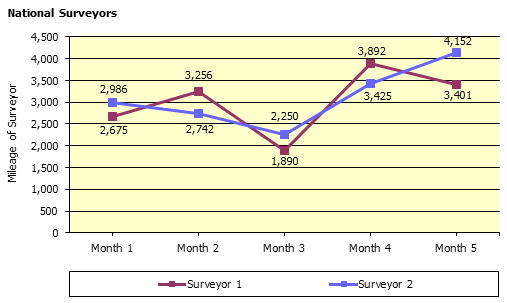
A. Month 1 and 2
B. Month 2 and 3
C. Month 3 and 4
D. Month 4 and 5
Answer:
The correct answer is (D) - Months 4 and 5
To determine the rate of increase or decrease between two values, use this formula:
(New value − Old value) ÷ Old value
Notice!
In this case, the sign (negative or positive) only indicates a decrease or an increase respectively, and does not affect the number's value:
A result of a negative sign indicates a decrease.
A result of a positive sign indicates an increase.
Therefore, the rate of increase or decrease between two months will be calculated as:
(Mileage in the current month − Mileage in the previous month) ÷ Mileage in the previous month
Between months 1 and 2:
(3,256 − 2,675) ÷ 2,675 = 0.217 = 21.7% ⇒ between months 1 and 2 there was an increase of 21.7%
Between months 2 and 3:
(1,890 − 3,256) ÷ 3,256 = −0.419 = −41.9% ⇒ between months 2 and 3 there was a decrease of 41.9%
Between months 3 and 4:
(3,892 − 1,890) ÷ 1,890 = 1.059 = 105.9% ⇒ between months 3 and 4 there was an increase of 105.9%
Between months 4 and 5:
(3,401 − 3,892) ÷ 3,892 = −0.126 = −12.6% ⇒ between months 4 and 5 there was a decrease of 12.6%
Since the question asks for the smallest increase OR decrease (without differentiating an increase from a decrease), you can ignore the negative signs where they appear and relates to all values as absolute values:
12.6% < 21.7% < 41.9% < 105.9%
As can be seen, 12.6% is the smallest value.
You don't have to struggle to pass your Hudson Numerical test. Our Hudson-style preparation materials are the most comprehensive available online. Use our exclusive Hudson practice tests, study guides, video tutorials, and more to improve your numerical abilities. Other Numerical Reasoning preparations include: Saville, Aon cut-e, SHL.
Sample Question 10
10. Of all survey respondents, What is the approximate percentage, who enjoy either watching TV or playing sports?
A. 35%
B. 37%
C. 39%
D. 41%
E. None of these
Answer:
The correct answer is (A) - 37%
In the adult group, 23% watch TV, and 15% play sports = 38%.
7600 x (38/100) = 2,888 adults enjoy watching TV and playing sports.
In the children’s group, 24% watch TV and 11% play sports = 35%.
2400 x (35/100) = 840 children enjoy watching TV and playing sports.
The total number of survey participants who enjoy watching TV and playing sports = 840 + 2,888 = 3,728.
From a total sample of 10,000, the percentage of people who enjoy watching TV and playing sports is approximately 37%.
The answer is 37%.
Shortcut:
This question could also be solved by approximation and knowledge of weighted averages:
The proportion of Adults is 38%. The proportion of Children is 35%. Since the size of the Adult group is larger than the Children's group, the numbers would have to be higher than 35%, slightly tending towards 38% but not hitting 38%. The only answer that follows this logic is 37%.
Master the Hudson Numerical Reasoning Test
The N-RAT 3R test is tough, but with the right preparation, you can ace it. Our expert-designed materials will help you:
- Simulate real test conditions to improve speed and accuracy.
- Practice targeted exercises to refine weak areas.
- Access study guides & video tutorials to deepen your understanding.
Don't wait – Start your preparation today and get ahead of the competition!
Sample Question 11
11. If the sample consists of 12,000 males and females, and we can assume that the number of females who prefer pasta is 649, then approximately how many males participated in the survey?
A. 2,400
B. 1,200
C. 5,900
D. 6,100
E. Cannot say
Answer:
The correct answer is (D) - 6100
The number of females who prefer pasta is 649. According to the middle column in the chart, these females make up 11% of all female respondents. This means you can create the following equation to find the number of females participating in the sample:
No. of females preferring pasta = Total no. of females x Percentage of female preferring pasta
Total no. of females = No. of females preferring pasta / Percentage of female preferring pasta
Total no. of females = 649 / 11% = 649 / 0.11 = 5,900
If the sample consists of 12,000 respondents, of which 5,900 are female, then the number of males in the survey is: 12,000-5,900 = 6,100.
An alternative solution path is to use the Males & Females column. Knowing that 12,000 people participated in the survey, of which 10.5% like pasta, you can calculate the number of people who like pasta:
12,000 x 10.5% = 12,000 x 0.105 = 1,260
You can then deduct the number of females who like pasta to get the number of males who like pasta:
1,260 - 649 = 611.
According to the left column of the chart, 10% of the males prefer pasta. If 611 males represent 10% of the total number of male participants in the survey, then there were 611 / 10% = 611 / 0.1 = 6110 male participants in the sample.
The fact that each solution path resulted in a slightly different number is not significant, since no other answer choice was near the correct answer.
The answer is 6,100.
In recent years, online aptitude tests have become very popular because they provide insight into an applicant's talents, limitations, and overall skill level. This Numerical Hudson test will include questions involving percentages, tables, and graphs.
Sample Question 12
12. If in 2005 the prices of a single ticket for lines PR, PE, RF, CD, and AC were £1.5, £2.5, £3.5, £4, and £5.5, respectively, and the annual operational costs of these lines (in tens of thousands) were £118.23, £194.15, £209.28, £241.76 and £220.02, respectively, which line had an annual profit of fewer than ½ million pounds?
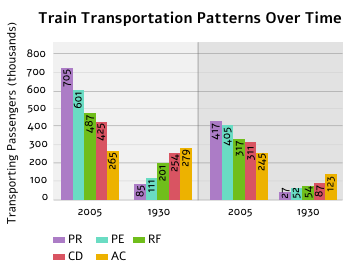
A. PR
B. PE
C. CD
D. AC
E. None of these
Answer:
The correct answer is (E) - None of these
In order to answer the question, you need to find each line’s profit.
Since Profit = Turnovers – Costs, you can start by calculating the turnovers of each line.
Turnovers = (No. of day time passengers + No. of night time passengers) x Price per ticket
Tip: As RF line is not one of the options, you can save time by ignoring it from now on.
PR: (705,000 + 417,000) x 1.5 = 1,683,000
PE: (601,000 + 405,000) x 2.5 = 2,515,000
CD: (425,000 + 311,000) x 4 = 2,944,000
AC: (265,000 + 245,000) x 5.5 = 2,805,000
Notice: the costs are given in tens of thousands. Thus, you need to multiply them by 10,000:
PR: 118.23 x 10,000 = 1,182,300
PE: 194.15 x 10,000 = 1,941,500
CD: 241.76 x 10,000 = 2,417,600
AC: 220.02 x 10,000 = 2,200,200
Now, you can finally find the annual profit of each line:
PR: 1,683,000 - 1,182,300 = 500,700
PE: 2,515,000 - 1,941,500 = 573,500
CD: 2,944,000 - 2,417,600 = 526,400
AC: 2,805,000 - 2,200,200 = 604,800
As you can see, none of the lines has an annual profit of fewer than ½ million pounds.
Therefore, the answer is ‘none of these'.
Sample Question 13
13. What is the approximate percentage change in profit per unit when a 12.5% discount is given for purchasing 150 units of Houston A?
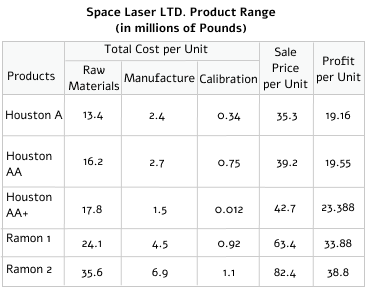
A. 13
B. 16
C. 23
D. 18
E. 14
Answer:
The correct answer is (C) - 23
There was a 12.5% discount on Houston A's sale price, meaning that there was a 12.5% change in the sale price. Translating this percentage change into £ is done using the formula:
Part = (%/100)*Total
Therefore,
(12.5/100)*35.3 = 0.125*35.3 = £4.4125
Now, calculate how much this change in £, constitutes, in %, out of the profit per unit, using the formula:
% = (Part/Total)*100
(4.4125/19.16)*100 = 0.23*100 = 23%
Notice! There is no need to consider 150 units since the 12.5% discount applies to each unit and therefore, a single unit is sufficient for calculating the loss in profit.
A longer, more elaborated way to solve this question is the following:
When a discount is given, the Profit per Unit is reduced while the costs remain constant.
The fixed costs are made of Raw Materials cost, Manufacture cost, and Calibration cost, which can be found under the 'Total Cost per Unit' in the table and it equals 13.4 + 2.4 + 0.34 = £16.14, which also equals sale price - profit:
Fixed costs = Sale price - Profit = 35.3-19.16 = £16.14
the sale price post discount is 100 - 12.5 = 87.5% of the original sale price.
Notice! There is no need to consider 150 units since the 12.5% discount applies to each unit and therefore, a single unit is sufficient for calculating the loss in profit.
The price after discount: 87.5%*35.3 = (87.5/100)*35.3 = 0.875*35.3 = £30.8875
Since Fixed costs = Sale price - Profit, as written above, extract the 'profit' from the formula:
Profit = Sale price - Fixed costs
Substituting the new sale price in the formula leads to a new profit per unit:
New profit per unit: 30.8875-16.14 = £14.7475
To find a percentage change, use the formula:
% Change = [(Old value - New value)/Old value]*100
Therefore, the percentage change in profit is:
[(19.16 - 14.7475)/19.16]*100 = (4.4125/19.16)*100 = 0.23*100 = 23%
Notice! A different form of writing the 'Percentage change' formula is:
% Change = [(Old value - New value)/Old value]*100 = [(Old value/Old value) - (New value/Old value)]*100 = [1 - (New value/Old value)]*100
Therefore, the percentage change in profit is:
[1-(new profit/old profit)]*100 = 1-(14.7475/19.16)*100 = 23%
Time management is crucial when answering Hudson Numerical questions. Answer each question individually within 90 seconds. If you cannot answer the question within the allotted time, you will be taken to the next question regardless of whether you have answered the question or not.
Sample Question 14
14. Due to a computer error, the data concerning ABC's fifth department (IT) failed to show on the table. It is known that 45 employees from the Admin department are working on Brand D. The same brand employs over 50% of IT employees. What is the maximal number of employees that might work in the IT department on Brand A?
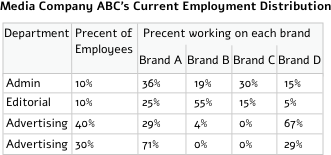
A. 300
B. 14
C. 149
D. 299
E. Cannot say
Answer:
The correct answer is (C) - 149
We are not given the full 100% of the employment distribution but you must not let this throw you. The first thing to do is use the number of administrators on Brand D (45) to calculate the total number of employees at the agency. We know from the table that 10% of the total number of employees are administrators and that 15% out of all administrators equals 45 on Brand D. Using this information we can find the total number of employees by calculating:
45 = 15% of 10% of the total, T
45 = 0.15 x 0.10 x T
T = 45 / 0.015 = 3,000
The next stage is to calculate the percentage of employees working in the IT department.
Adding up the four departments' percentages, we arrive at:
10+10+40+30=90%.
Therefore, the remaining 10% represents the IT department's proportion, which is in fact 300 workers (3000*0.1=300).
We are told that Brand D employs over 50% of the IT staff at ABC. Thus, at least 151 workers must work for Brand D, which leaves a maximum of 149 employees that might be working at brand A.
Therefore, the answer is 149 employees.
Sample Question 15
15. How many more employed graduates were there in 1990 than in 2000?
A. 75
B. 360
C. 485
D. 100
E. 135
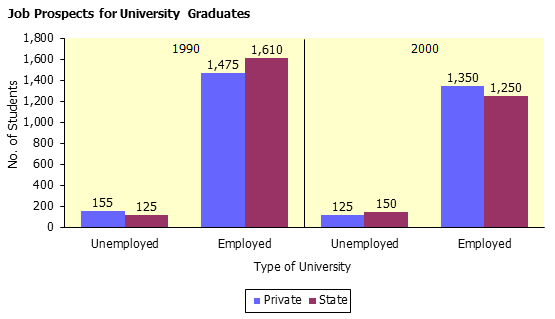
Answer:
The correct answer is (C) - 485
• The number of employed in 2000 = Private + State = 1,250 + 1,350 = 2,600.
• The number of employed in 1990 = Private + State = 1,475 + 1,610 = 3,085
• The difference in the number of employed in 1990 and 2000 = 3,085 - 2,600 = 485.
The answer is - 485
By practising, you will be able to beat the clock and answer each question in time. JobtTestPrep designed Hudson study materials to enhance your learning process, and increase your accuracy and speed. Other Numerical Reasoning preparations include: Saville, Aon cut-e, SHL.
Answer Index
| 1 | 2 | 3 | 4 | 5 |
| B | C | E | B | D |
| 6 | 7 | 8 | 9 | 10 |
| A | A | A | D | B |
| 11 | 12 | 13 | 14 | 15 |
| D | E | C | C | C |
Boost Your Score with the Hudson N-RAT 3R Preparation
Want to perform your best on the Hudson Numerical Reasoning Test? Get access to expert resources, including:
- Realistic Test Simulations – Get familiar with actual test conditions.
- Custom Practice Exercises – Focus on the skills you need to improve.
- Step-by-Step Tutorials – Learn test strategies from experts.
The best way to prepare is to practice
Continue Practicing for the Hudson Numerical Reasoning Exam
Access more Hudson Numerical Reasoning practice tests and other valuable Hudson Numerical Reasoning prep materials so that you take the test while being as prepared as possible:
- Free Hudson Numerical Reasoning Test - Includes 5 Hudson-Style Numerical reasoning tests and 10 numerical reasoning practice tests to sharpen your abilities in the test areas.
- The Hudson Abstract Reasoning Ability Prep - Contains 3 Full-length Hudson-style Abstract Reasoning Practice Tests and 9 Additional Diagrammatic Drills.
- Hudson Verbal Reasoning Ability Test- This is a general info page about the test.
- Pre-Employment Personality Prep- A full personality practice test with detailed job-Specific feedback along with Single Trait practice tests that contain customized questions arranged by traits


